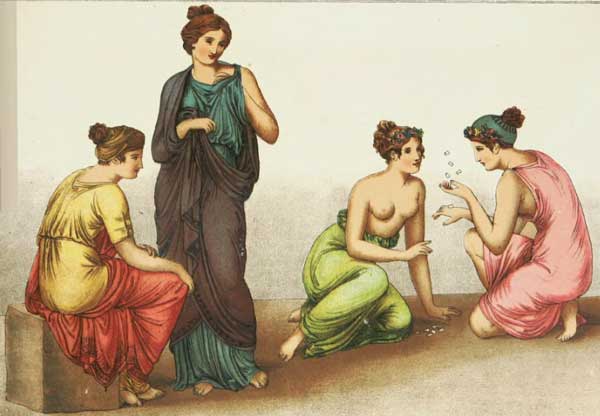.

Polygnotus (Polygnotos) was a Greek painter in the middle of the 5th century BC, son of Aglaophon. He was a native of Thasos, but was adopted by the Athenians, and admitted to their citizenship.
He painted for them in the time of Cimon a picture of the taking of Ilium on the walls of the Stoa Poecile, and another of the marriage of the daughters of Leucippus in the Anaceum. In the hall at the entrance to the Acropolis other works of his were preserved. The most important, however, of his paintings were his frescoes in a building erected at Delphi by the people of Cnidus. The subjects of these were the visit to Hades by Odysseus, and the taking of Ilium.
Fortunately the traveller Pausanias has left us a careful description of these paintings, figure by figure (Paus. X. 25-31). The foundations of the building have been recovered in the course of the French excavations at Delphi. From this evidence, some archaeologists have tried to reconstruct the paintings, excepting of course the colours of them. The figures were detached and seldom overlapping, ranged in two or three rows one above another; and the farther were not smaller nor dimmer than the nearer. It will hence appear that paintings at this time were executed on almost precisely the same plan as contemporary sculptural reliefs.

Iliou Persis painting of Polygnotus

A reconstruction in the period 1892/1893 by C. Robert of the two paintings of Polygnotus from the Lesche of the Knidians based on a description of Pausanias. Later reconstructions using archaeological information divide each painting into three separate paintings
[In a painting of Hades by Polygnotos at Delphi, Phokis] Eurynomos, said by the Delphian guides to be one of the daimones of Hades, who eats off all the flesh of the corpses, leaving only their bones. But Homer’s Odyssey, the poem called the Minyad, and the Returns, although they tell of Hades and its horrors, know of no daimon called Eurynomos. However, I will describe what he is like and his attitude in the painting. He is of a colour between blue and black, like that of meat flies; he is showing his teeth and is seated, and under him is spread a vulture’s skin.” -Pausanias 10.28.7
We learn also that Polygnotus employed but few colours, and those simple. Technically his art was primitive. His excellence lay in the beauty of his drawing of individual figures; but especially in the "ethical" and ideal character of his art. The contemporary, and perhaps the teacher, of Pheidias, he had the same grand manner. Simplicity, which was almost childlike, sentiment at once noble and gentle, extreme grace and charm of execution, marked his works, in contrast to the more animated, complicated and technically superior paintings of a later age.
F. B. Tarbell A History of Greek Art :
As regards the style of Polygnotus we can glean a few interesting facts from our ancient authorities. His figures were not ranged on a single line, as in contemporary bas-reliefs, but were placed at varying heights, so as to produce a somewhat complex composition.
His palette contained only four colors, black, white, yellow, and red, but by mixing these he was enabled to secure a somewhat greater variety. He laid his colors on in "flat" tints, just as the Egyptian decorators did, making no attempt to render the gradations of color due to varying light and shade. His pictures were therefore rather colored drawings than genuine paintings, in our sense of the term. He often inscribed beside his figures their names, according to a common practice of the time. Yet this must not be taken as implying that he was unable to characterize his figures by purely artistic means. On the contrary, Polygnotus was preeminently skilled in expressing character, and it is recorded that he drew the face with a freedom which archaic art had not attained. In all probability his pictures are not to be thought of as having any depth of perspective; that is to say, although he did not fail to suggest the nature of the ground on which his figures stood and the objects adjacent to them, it is not likely that he represented his figures at varying distances from the spectator or gave them a regular background.
It is clear that Polygnotus was gifted with artistic genius of the first rank and that he exercised a powerful influence upon contemporaries and successors. Yet, alas! in spite of all research and speculation, our knowledge of his work remains very shadowy. A single drawing from his hand would be worth more than all that has ever been written about him.
See also
See also Painting (Zographia, Graphe)
Stelios Lydakis, Ancient Greek Painting and Its Echoes in Later Art Publisher: Getty Publishing ISBN: 0892366834
Polygnotos and Vase Painting in Classical Athens
This article incorporates text from the public domain 1911 Encyclopædia Britannica.
Greeks:
A - B - C - D - E - F - G - H - I - J - K - L - M -
N - O - P - Q - R - S - T - U - V - W - X - Y - Z
| Ancient Greece
Science, Technology , Medicine , Warfare, , Biographies , Life , Cities/Places/Maps , Arts , Literature , Philosophy ,Olympics, Mythology , History , Images Medieval Greece / Byzantine Empire Science, Technology, Arts, , Warfare , Literature, Biographies, Icons, History Modern Greece Cities, Islands, Regions, Fauna/Flora ,Biographies , History , Warfare, Science/Technology, Literature, Music , Arts , Film/Actors , Sport , Fashion --- |
Retrieved from "http://en.wikipedia.org"
All text is available under the terms of the GNU Free Documentation License

